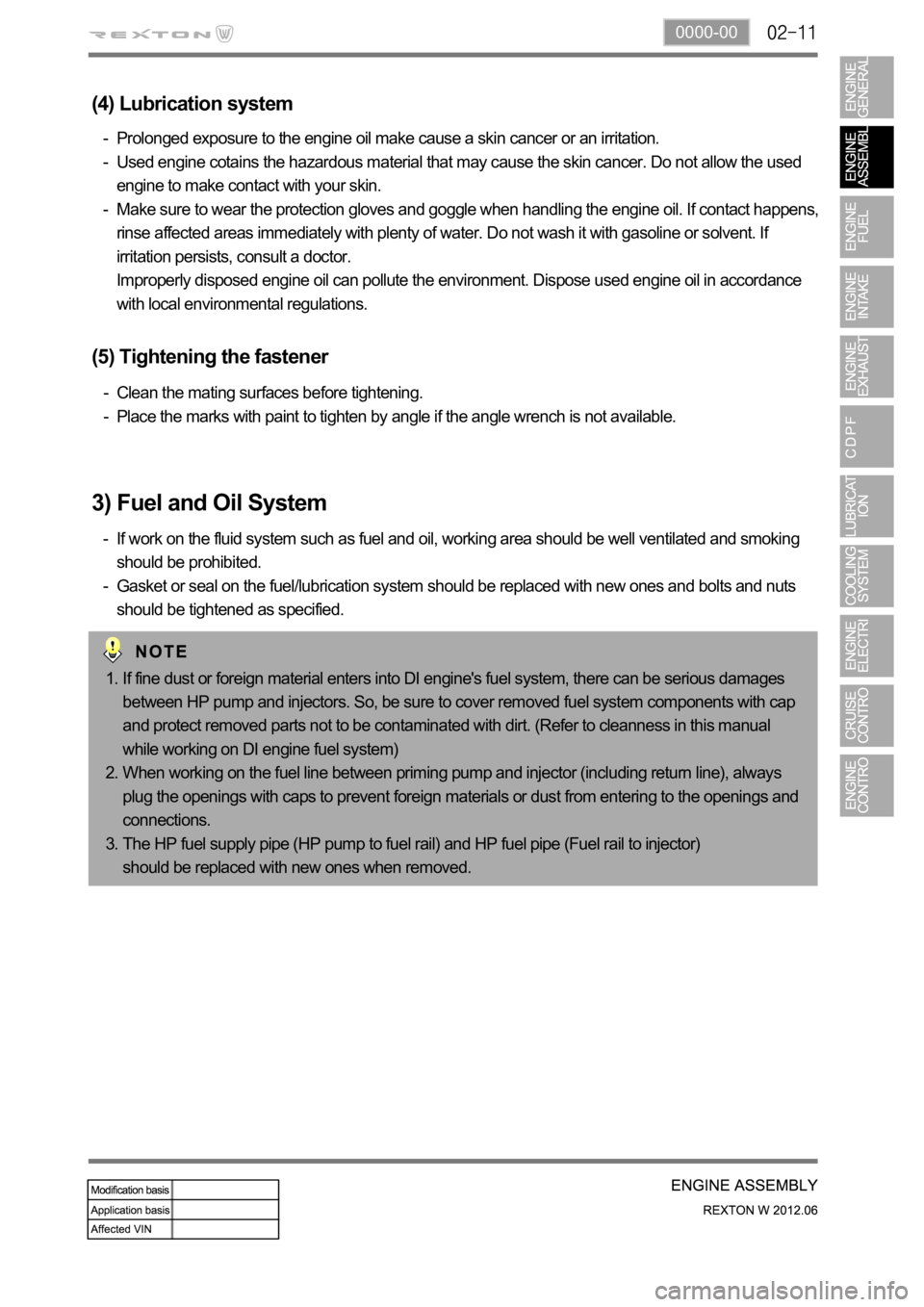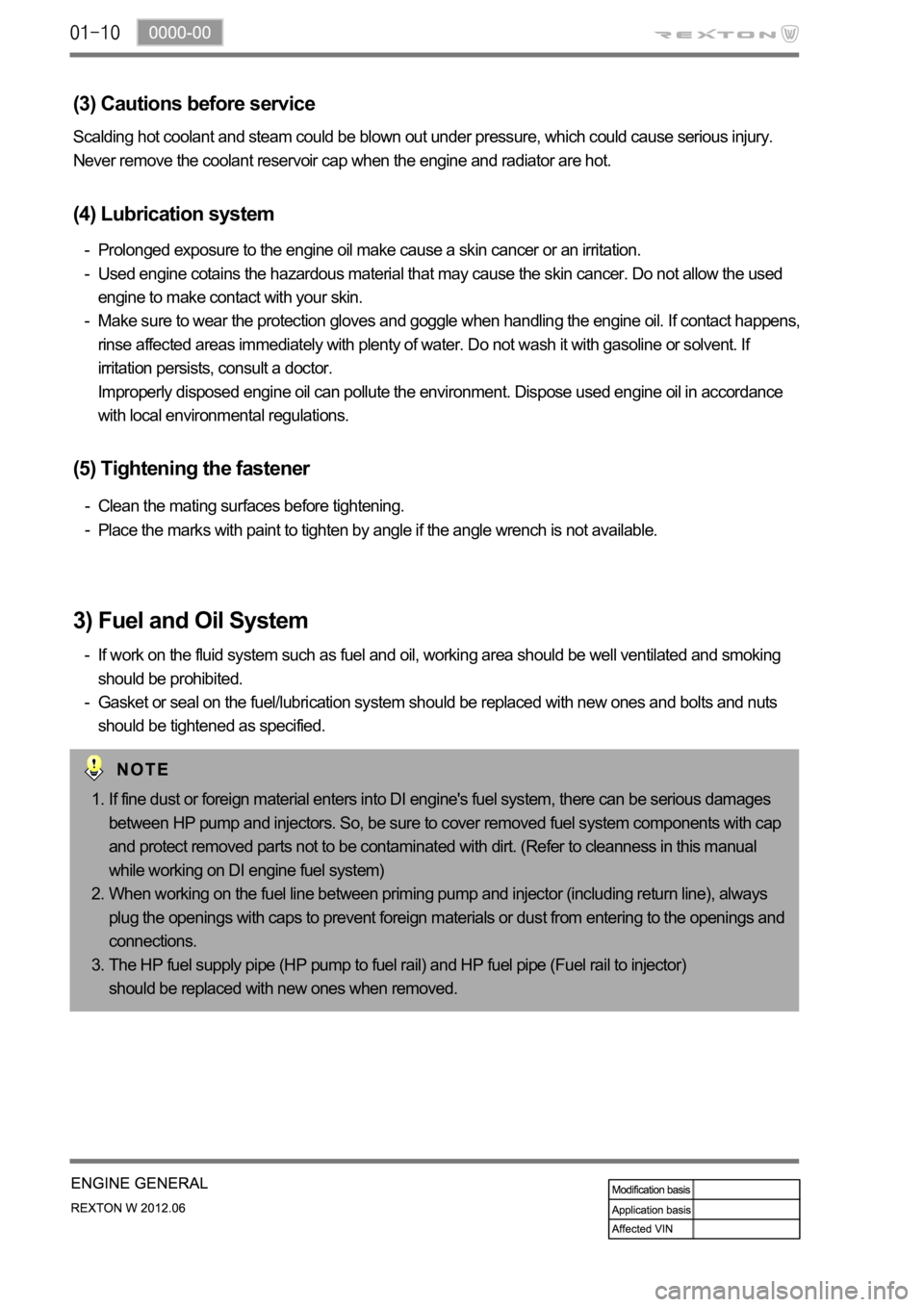Page 184 of 600
0000-00
Knock sensor (one) and
water temperature sensor
Fuel rail sensor (common
rail)
1. LOCATION OF MAJOR SENSORS ON ENGINE
Major sensors and devices
InjectorGlow plugCommon rail
Camshaft position sensorBoost pressure sensor
Crankshaft position
sensor
HP pumpCommon rail
Injector
Turbocharger vacuum
modulator
Page 190 of 600
0000-00
CDPF
Throttle body
Turbocharger vacuum modulator
EGR cooler
EGR pipe: Exhaust gas passage for recirculating
the exhaust gas
Intercooler
Intake manifold
DOCDPF
Coolant
port
Intake
manifold Exhaust
gas
To water
pump
Page 191 of 600
Water pump and pipe
6. LAYOUT OF COOLING SYSTEM
From heaterThermostat (internal)
Reservoir
(coolant inlet hose)
Radiator
Radiator
Return hose
Coolant reservoir tank
From
heater
Radiator
Reservoir
(coolant inlet hose)
EEGR cooler
EGR cooler
Coolant port
Water pump
Page 206 of 600

0000-00
(4) Lubrication system
Prolonged exposure to the engine oil make cause a skin cancer or an irritation.
Used engine cotains the hazardous material that may cause the skin cancer. Do not allow the used
engine to make contact with your skin.
Make sure to wear the protection gloves and goggle when handling the engine oil. If contact happens,
rinse affected areas immediately with plenty of water. Do not wash it with gasoline or solvent. If
irritation persists, consult a doctor.
Improperly disposed engine oil can pollute the environment. Dispose used engine oil in accordance
with local environmental regulations. -
-
-
(5) Tightening the fastener
Clean the mating surfaces before tightening.
Place the marks with paint to tighten by angle if the angle wrench is not available. -
-
3) Fuel and Oil System
If work on the fluid system such as fuel and oil, working area should be well ventilated and smoking
should be prohibited.
Gasket or seal on the fuel/lubrication system should be replaced with new ones and bolts and nuts
should be tightened as specified. -
-
If fine dust or foreign material enters into DI engine's fuel system, there can be serious damages
between HP pump and injectors. So, be sure to cover removed fuel system components with cap
and protect removed parts not to be contaminated with dirt. (Refer to cleanness in this manual
while working on DI engine fuel system)
When working on the fuel line between priming pump and injector (including return line), always
plug the openings with caps to prevent foreign materials or dust from entering to the openings and
connections.
The HP fuel supply pipe (HP pump to fuel rail) and HP fuel pipe (Fuel rail to injector)
should be replaced with new ones when removed. 1.
2.
3.
Page 237 of 600
0000-00
PWM Fan Assembly
Water Pump
Port to EGR coolerCoolant Port
EGR Cooler
PWM fan unit
Fan Flap doorFrom coolant port
To water pump
Radiator
1. LAYOUT OF COOLING SYSTEM
Coolant reservoir
Page 238 of 600
1. COMPARISON IN COOLING SYSTEM FOR EACH ENGINE
For the D20DT (EURO4) engine, the cooling system is equipped with E-EGR cooler and the water pump
which its capacity is improved according to the additional coolant line in the cylinder block.
Page 258 of 600
2. MAJOR COMPONENTS
Front view
Vacuum pump
Camshaft position sensor
Oil filter assembly
Power steering pump pulley
Oil pressure switch
Idler pulley No. 2
Water pump pulley
Alternator pulley
Auto tensioner
Idler pulley No. 1
A/C compressor pulley
Rear view
E-EGR valve
Fuel temperature sensor
Fuel HP pump assembly
Coolant temperature sensor
IMV valve Crankshaft position sensor
Isolation damper
Page 264 of 600

(3) Cautions before service
Prolonged exposure to the engine oil make cause a skin cancer or an irritation.
Used engine cotains the hazardous material that may cause the skin cancer. Do not allow the used
engine to make contact with your skin.
Make sure to wear the protection gloves and goggle when handling the engine oil. If contact happens,
rinse affected areas immediately with plenty of water. Do not wash it with gasoline or solvent. If
irritation persists, consult a doctor.
Improperly disposed engine oil can pollute the environment. Dispose used engine oil in accordance
with local environmental regulations. -
-
-
(5) Tightening the fastener
If fine dust or foreign material enters into DI engine's fuel system, there can be serious damages
between HP pump and injectors. So, be sure to cover removed fuel system components with cap
and protect removed parts not to be contaminated with dirt. (Refer to cleanness in this manual
while working on DI engine fuel system)
When working on the fuel line between priming pump and injector (including return line), always
plug the openings with caps to prevent foreign materials or dust from entering to the openings and
connections.
The HP fuel supply pipe (HP pump to fuel rail) and HP fuel pipe (Fuel rail to injector)
should be replaced with new ones when removed. 1.
2.
3. Scalding hot coolant and steam could be blown out under pressure, which could cause serious injury.
Never remove the coolant reservoir cap when the engine and radiator are hot.
(4) Lubrication system
3) Fuel and Oil System
If work on the fluid system such as fuel and oil, working area should be well ventilated and smoking
should be prohibited.
Gasket or seal on the fuel/lubrication system should be replaced with new ones and bolts and nuts
should be tightened as specified. -
-Clean the mating surfaces before tightening.
Place the marks with paint to tighten by angle if the angle wrench is not available. -
-